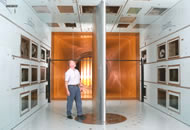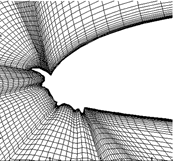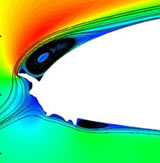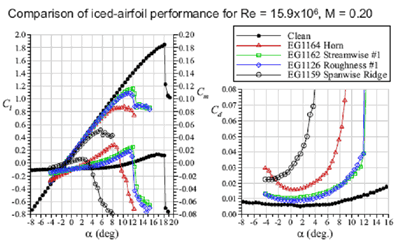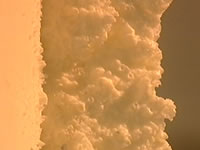A better understanding of the formation of ice on aircraft, helping the aircraft builders to prove that their aircraft can cope, and eliminating the most dangerous ice: these are the objectives of Sunset, a joint research project between Onera and Nasa.
Number 45
|
|
Ice is the most common non-human cause of aircraft accidents. It interfers with the engines, affects the aerodynamic performance of the aircraft, and causes deterioration of the sensors. No wonder aircraft builders pay it particular attention: how can we prevent it? How can we minimize its effects? Above all, we need to understand how it forms, and then design airfoils that stop it from forming. This is the objective of Sunset, an Onera-Nasa joint project, aimed at better understanding how ice forms, and developing digital models that aircraft builders can use to prove that their aircraft can fly without danger in freezing conditions. |
|
There are in fact several types of ice. The variant that causes most degradation of aircraft performance when the temperature is close to zero is called the "runback refreezing barrier". It can form in extreme freezing conditions with drops of large diameter (drizzle or freezing rain). Then there is glaze ice whereby local trickles of water form horns of ice thus lowering the aerodynamic performance of the aircraft. These are the transparent types that are to be avoided at all costs, while rime ice, which occurs when the temperature is well below zero, is less dangerous.
Wind tunnel tests are essential for studying the effects of ice on the aerodynamics of an aircraft. Problem: there is no full size wind tunnel equipped with cooling systems appropriate for the study of ice on large aircraft. "When the forms of ice are reproduced on reduced scale mockups, the aerodynamic degradations that are obtained are much greater than those observed at scale 1" explains Didier Gufford, researcher in the Physics and Instrumentation Department at Onera. |
|
|
|
Therefore, the researchers have had to find correspondences between the forms of ice at reduced scale and those at scale 1. In other words, find at what size the patterns of ice at reduced scale have the same effect as those at scale 1. To do this, the researchers at Onera, working with those at Nasa, have used the icing wind tunnel of the Glenn Center in Cleveland USA, and they have obtained scale 1 results on smaller aircraft profiles, which they were able to compare with the results on reduced scale profiles, and so establish correspondences. |
|
Onera and Nasa have reproduced the forms of ice, dimensioned in the manner described, using resin molds, and so run tests at reduced scale that are representative of real scale phenomena. The wing profiles on which these “sculptures” are positioned may then be tested in wind tunnels at any temperature. So a good quantity of data is obtained, which is necessary if the digital simulations are to be validated. |
|
| "This joint work with Nasa finished in 2008, but it worked so well that Nasa suggested an extension until 2011, which it usually never does", enthused Didier Guffond. This extension meant that the scale 1 data could be better used, and the simulations improved. The ultimate aim is of course to find a way of reducing or eliminating this dangerous ice. At the moment, on large aircraft, hot air at 180°C is taken from the engine to melt the ice. According to Didier Gufford, air at 80°C would be sufficient, provided the heat exchanges between the voilure and the environment were increased. |
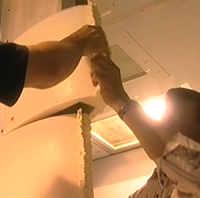 Mise en place sur l'aile dans la veine de la soufflerie d'une sculpture de bord d'attaque en résine, doté d'une des quatre formes de givre du programme Sunset |
| "When water touches the airfoil, it evacuates the heat when it soldifies” explains the researcher. If this heat is not evacuated sufficiently then some of the water trickles and transparent ice, the most dangerous, forms. So we need to increase the heat exchanges inside the wing or circulate hot air to improve efficiency". | |
Cécile Michaut, scientific reporter.



